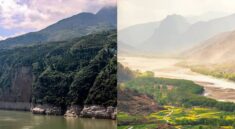Nestled within the spectacular landscapes of Fiordland National Park on New Zealand’s South Island, Milford Sound stands as a testament to the breathtaking beauty of nature. This iconic fjord, renowned for its awe-inspiring scenery, is a must-visit destination that captivates travelers with its towering peaks, cascading waterfalls, and serene waters.
As you approach Milford Sound, the sheer grandeur of the towering cliffs and snow-capped peaks creates a dramatic entrance. The fjord stretches over 15 kilometers inland, flanked by steep mountains that rise majestically from the water. Mitre Peak, a distinctive triangular peak, commands attention as one of the most photographed features of Milford Sound.
Milford Sound is adorned with an array of waterfalls that cascade down from the cliffs, creating a mesmerizing symphony of nature. Stirling Falls, one of the tallest waterfalls in New Zealand, tumbles gracefully into the sound, while Bowen Falls adds its own ethereal charm. These cascades, fueled by the region’s abundant rainfall, contribute to the mystical ambiance of Milford Sound.
The pristine waters of Milford Sound are home to diverse marine life, including seals, dolphins, and occasionally, the elusive Fiordland crested penguin. Cruise excursions provide an opportunity to witness these creatures in their natural habitat, adding a touch of wildlife charm to the fjord experience.
For those seeking a land-based adventure, the Milford Track is a world-renowned hiking trail that takes trekkers through lush rainforests, alpine meadows, and across mountain passes. This multi-day journey is considered one of the finest walks globally, allowing hikers to immerse themselves in the heart of Fiordland.
How to get there
Getting to Milford Sound involves a scenic journey through New Zealand’s South Island, surrounded by stunning landscapes. The primary gateway to Milford Sound is the town of Te Anau, which serves as a common base for travelers. Here are the main transportation options:
1. By Car:
- Te Anau to Milford Sound: The most common route is to drive from Te Anau to Milford Sound. The journey takes approximately 2 hours and covers around 120 kilometers (75 miles). The road offers breathtaking views, including Mirror Lakes and the Homer Tunnel.
- Queenstown to Milford Sound: If you are coming from Queenstown, the drive to Milford Sound takes about 4 hours, covering approximately 290 kilometers (180 miles). The route passes through Te Anau.
2. Coach/Bus Tours:
- Numerous tour operators offer coach or bus tours from Te Anau or Queenstown to Milford Sound. These guided tours provide commentary about the region’s natural features, and some include boat cruises on Milford Sound. The journey itself becomes part of the experience.
3. Scenic Flights:
- For a unique and aerial perspective, consider taking a scenic flight from Queenstown or Te Anau to Milford Sound. These flights offer stunning views of the Southern Alps and Fiordland National Park.
4. Milford Track:
- Hikers embarking on the Milford Track will typically start their journey with a boat ride across Lake Te Anau, followed by a walk along the track, eventually reaching Milford Sound.
5. Cruise and Kayak Tours:
- Some tour operators offer packages that include a combination of transport and activities, such as a cruise on Milford Sound or even kayaking in the fjord.
Tips:
- Weather Considerations: The weather in Fiordland can be unpredictable, and road closures are possible, especially during winter. Check weather forecasts and road conditions before your journey.
- Book in Advance: Especially during peak tourist seasons, it’s advisable to book transportation and tours in advance to secure your preferred time and avoid disappointment.
- Self-Drive Options: If you choose to drive, ensure your vehicle is in good condition, and be aware of the road conditions. Some rental car companies offer GPS-guided audio commentary to enhance the scenic drive.
Things to do
Milford Sound offers a range of activities that allow visitors to immerse themselves in the breathtaking natural beauty of the region. From boat cruises to hiking and wildlife encounters, here are some recommended things to do in Milford Sound:
**1. Boat Cruises:
- Scenic Cruise: Embark on a scenic boat cruise on Milford Sound to marvel at the towering fjords, cascading waterfalls, and sheer cliffs. Many cruises offer informative commentary about the natural features and wildlife.
- Overnight Cruise: Consider an overnight cruise for a more immersive experience. Spend a night on the sound, enjoy stargazing, and wake up to the serene beauty of the fjord.
- Nature Cruises: Some operators offer nature-focused cruises with naturalists on board, providing insights into the flora, fauna, and geological wonders of Milford Sound.
**2. Kayaking:
- Explore Milford Sound from a different perspective by kayaking on its calm waters. Paddle along the fjord’s edges, getting up close to the waterfalls and cliffs. Guided kayaking tours are available for all experience levels.
**3. Scenic Flights:
- Take to the skies on a scenic flight to witness Milford Sound’s grandeur from above. Aerial tours provide stunning views of the fjords, mountains, and lakes in the surrounding Fiordland National Park.
**4. Hiking:
- Milford Track: One of New Zealand’s Great Walks, the Milford Track is a multi-day hiking trail that takes you through diverse landscapes, including rainforests, alpine meadows, and mountain passes.
- Key Summit Track: For a shorter hike, consider the Key Summit Track, which offers panoramic views of the surrounding mountains and valleys.
**5. Wildlife Viewing:
- Keep an eye out for wildlife during your boat cruise. Seals, dolphins, and penguins are often spotted in the waters of Milford Sound.
**6. Underwater Observatory:
- Visit the Milford Sound Underwater Observatory for a unique glimpse into the underwater world of the fjord. Observe the marine life beneath the surface, including black coral and other fascinating creatures.
**7. Photography:
- Milford Sound is a photographer’s paradise. Capture the dramatic landscapes, reflections in the water, and the play of light on the cliffs during sunrise and sunset.
**8. Stargazing:
- On clear nights, the remote location of Milford Sound provides an excellent opportunity for stargazing. Enjoy the pristine night sky and identify constellations.
**9. Visit the Milford Sound Discovery Center:
- Learn more about the natural and cultural history of the region at the Milford Sound Discovery Center. Interactive exhibits provide insights into the geological formation of the fjords and the diverse ecosystems.
**10. Cruise and Kayak Combinations: – Some tour operators offer combined experiences that include both a boat cruise and kayaking, allowing you to enjoy the best of both worlds.
Things not to forget
When visiting Milford Sound, it’s essential to be well-prepared to fully enjoy your experience in this remote and stunning location. Here’s a list of things not to forget:
**1. Rain Gear:
- Milford Sound is known for its high rainfall, and weather conditions can change rapidly. Bring a waterproof jacket, pants, and suitable footwear to stay dry during potential rain showers.
**2. Insect Repellent:
- In certain seasons, sandflies can be prevalent. Pack insect repellent to protect yourself from these tiny, biting insects.
**3. Camera and Binoculars:
- Capture the breathtaking scenery and wildlife with a camera or smartphone. Binoculars can enhance your experience by allowing you to see details, especially during wildlife encounters.
**4. Layers of Clothing:
- Dress in layers to adapt to changing temperatures. Even during warmer seasons, temperatures can vary, and it can get chilly, especially on the water or at higher altitudes.
**5. Sun Protection:
- Bring sunscreen with a high SPF to protect your skin from the strong New Zealand sun. Don’t forget sunglasses and a wide-brimmed hat for additional protection.
**6. Daypack:
- Carry a small daypack to hold essentials like water, snacks, a camera, and any additional layers of clothing.
**7. Water and Snacks:
- Stay hydrated by carrying a reusable water bottle. Pack some snacks like energy bars, nuts, or fruits to keep your energy levels up during activities.
**8. Comfortable Footwear:
- Wear sturdy and comfortable shoes suitable for walking or hiking, especially if you plan to explore nearby trails.
**9. Travel Adapters:
- If you’re visiting from a country with different electrical outlets, bring a travel adapter to charge your electronic devices.
**10. Valid Identification and Tickets: – Carry valid identification, such as a passport, and any tickets or reservations you may need for boat cruises or other activities.
**11. Medications and First Aid Kit: – Bring any necessary medications and a basic first aid kit for minor injuries or ailments.
**12. Travel Insurance: – Consider having travel insurance that covers medical emergencies and unexpected situations. Check your coverage and emergency contact information.
**13. Map or GPS: – Have a map or use a GPS app to navigate the area, especially if you plan to explore trails or visit specific viewpoints.
**14. Cash: – While some services may accept cards, it’s a good idea to carry some local currency for small purchases or tips.
**15. Respectful Attire: – Dress modestly and comfortably, especially if you plan to participate in outdoor activities or visit cultural attractions.
**16. Booking Confirmations: – If you’ve booked tours or accommodations in advance, carry printed or digital copies of your booking confirmations.
Best time to visit
The best time to visit Milford Sound depends on your preferences and the type of experience you seek. Milford Sound experiences a temperate climate, and each season offers unique advantages. Here’s a breakdown of the seasons to help you plan your visit:
**1. Summer (December to February):
- Pros: Summer brings warmer temperatures, with daytime highs ranging from 19°C to 22°C (66°F to 72°F). The days are longer, providing more daylight for outdoor activities. This season is ideal for boat cruises, kayaking, and hiking.
- Cons: Summer is the peak tourist season, and Milford Sound can be busier. Booking accommodations and activities in advance is recommended. The weather can still be unpredictable, with occasional rain.
**2. Autumn (March to May):
- Pros: Autumn offers milder temperatures and stunning fall foliage, creating a picturesque landscape. The number of tourists begins to decrease compared to the summer months. The weather is generally stable, making it a good time for outdoor exploration.
- Cons: Days start to shorten, and the weather can become cooler, especially in the evenings. While it’s less crowded than summer, it’s still advisable to book in advance.
**3. Winter (June to August):
- Pros: Winter is the least crowded season, providing a more intimate experience. Snow-capped peaks and a quieter atmosphere add to the beauty of the fjord. Scenic flights over the snow-covered landscape offer a unique perspective.
- Cons: Winter temperatures can range from 2°C to 8°C (36°F to 46°F), and snow is possible. Some activities may have limited availability, and road conditions can be challenging. It’s essential to check weather forecasts and road conditions before traveling.
**4. Spring (September to November):
- Pros: Spring brings a sense of renewal, with blooming flowers and returning wildlife. The weather starts to warm up, and daylight hours increase. It’s a transitional period with fewer tourists compared to summer.
- Cons: Spring can still have some rainfall, and temperatures may vary. It’s advisable to bring layers of clothing to accommodate changing conditions.
Tips for Choosing the Best Time:
- Wildlife Viewing: If wildlife viewing is a priority, consider visiting during the warmer months when seals, dolphins, and penguins are more active.
- Scenic Flights: Winter offers a unique opportunity for scenic flights over snow-covered landscapes. However, check weather conditions and be aware of potential flight disruptions.
- Hiking: Summer and early autumn are ideal for hiking, with longer daylight hours and more predictable weather.
- Photography: The fjord looks stunning in all seasons, but photographers may appreciate the soft lighting and dramatic skies of autumn and winter.
What is so special about Milford Sound?
Milford Sound is renowned for its extraordinary natural beauty and is often considered one of the most stunning fjords in the world. Several features contribute to the special allure of Milford Sound:
- Spectacular Scenery:
- The fjord is surrounded by towering, sheer cliffs that rise dramatically from the water. The landscape is dominated by majestic peaks, including the iconic Mitre Peak, which stands at the entrance of Milford Sound and reaches an elevation of 1,692 meters (5,551 feet).
- Waterfalls:
- Milford Sound is adorned with numerous waterfalls, some of which plunge directly into the fjord from the steep cliffs. Notable waterfalls include Stirling Falls, Bowen Falls, and Lady Bowen Falls. The sound of cascading water adds to the enchanting ambiance of the area.
- Wildlife Encounters:
- The fjord is home to a variety of wildlife, including seals, dolphins, and sometimes even penguins. Visitors on boat cruises have the opportunity to witness these animals in their natural habitat, creating memorable wildlife encounters.
- Dramatic Weather:
- Milford Sound is known for its dramatic and ever-changing weather. Mist and rain often shroud the cliffs, creating an ethereal atmosphere. The weather conditions contribute to the fjord’s mystical and mysterious allure, adding to the sense of grandeur.
- Fiordland National Park:
- Milford Sound is situated within Fiordland National Park, a UNESCO World Heritage site known for its pristine wilderness. The park encompasses a diverse range of landscapes, including fiords, mountains, lakes, and rainforests, making it a haven for nature lovers and outdoor enthusiasts.
- Reflective Waters:
- On calm days, the waters of Milford Sound reflect the surrounding peaks and cliffs, creating mirror-like reflections. This phenomenon enhances the visual impact of the fjord, making it a photographer’s paradise.
- Milford Track:
- The Milford Track, one of New Zealand’s Great Walks, starts at Lake Te Anau and ends at Milford Sound. Hiking the track allows trekkers to experience the diverse landscapes of Fiordland, culminating in the breathtaking scenery of Milford Sound.
- Underwater Observatory:
- The Milford Sound Underwater Observatory provides a unique perspective on the marine life beneath the surface. Visitors can observe black coral and other underwater species in their natural habitat.
- Stargazing Opportunities:
- Milford Sound’s remote location offers excellent stargazing opportunities on clear nights. The absence of light pollution allows visitors to enjoy a pristine view of the night sky.
What is the closest city to Milford Sound New Zealand?
The closest city to Milford Sound in New Zealand is Queenstown. Queenstown is a popular tourist destination located on the South Island, and it serves as a major gateway to the Fiordland region, where Milford Sound is situated.
The distance between Queenstown and Milford Sound is approximately 287 kilometers (178 miles) by road. The journey from Queenstown to Milford Sound takes around 4 hours by car, depending on road conditions and stops along the way.
While Queenstown is the closest major city, Te Anau is another town worth mentioning. Te Anau is situated closer to Milford Sound than Queenstown and is often used as a base for visitors exploring the region. The distance from Te Anau to Milford Sound is approximately 119 kilometers (74 miles), and the drive takes about 2 hours.
Both Queenstown and Te Anau offer various accommodations, amenities, and tour services for travelers planning to visit Milford Sound, making them convenient starting points for the journey to this iconic fjord.
What is best month to visit Milford Sound?
The best month to visit Milford Sound in New Zealand depends on your preferences and the type of experience you are seeking. Milford Sound experiences a temperate climate with some variations throughout the year. Here are some considerations for different months:
**1. Summer (December to February):
- Pros: Warmer temperatures, with daytime highs ranging from 19°C to 22°C (66°F to 72°F). Longer daylight hours provide more time for outdoor activities. This is the peak tourist season, and the fjord is bustling with activity.
- Cons: Crowded conditions, especially during the holiday season. Higher chance of rainfall, but the weather is generally more predictable.
**2. Autumn (March to May):
- Pros: Mild temperatures and stunning fall foliage, creating a picturesque landscape. The number of tourists starts to decrease compared to the summer months. Generally stable weather, making it a good time for outdoor exploration.
- Cons: Days start to shorten, and the weather can become cooler, especially in the evenings.
**3. Winter (June to August):
- Pros: Winter is the least crowded season, providing a more intimate experience. Snow-capped peaks and a quieter atmosphere add to the beauty of the fjord. Scenic flights over the snow-covered landscape offer a unique perspective.
- Cons: Winter temperatures can range from 2°C to 8°C (36°F to 46°F), and snow is possible. Some activities may have limited availability, and road conditions can be challenging. Check weather forecasts and road conditions before traveling.
**4. Spring (September to November):
- Pros: Spring brings a sense of renewal, with blooming flowers and returning wildlife. The weather starts to warm up, and daylight hours increase. It’s a transitional period with fewer tourists compared to summer.
- Cons: Spring can still have some rainfall, and temperatures may vary. It’s advisable to bring layers of clothing to accommodate changing conditions.
Factors to Consider:
- Wildlife Viewing: If wildlife viewing is a priority, consider visiting during the warmer months when seals, dolphins, and penguins are more active.
- Photography: The fjord looks stunning in all seasons, but photographers may appreciate the soft lighting and dramatic skies of autumn and winter.
- Activities: Different seasons offer various activities. Summer is ideal for boat cruises and hiking, while winter provides a unique snow-covered landscape.
- Weather: Milford Sound is known for its high rainfall, so be prepared for the possibility of rain at any time of the year. The weather can be unpredictable, so it’s advisable to bring waterproof clothing and check forecasts.
Ultimately, the best time to visit Milford Sound depends on your personal preferences and the type of experience you want to have in this awe-inspiring natural wonder.
Image credit : content.paulreiffer.com





